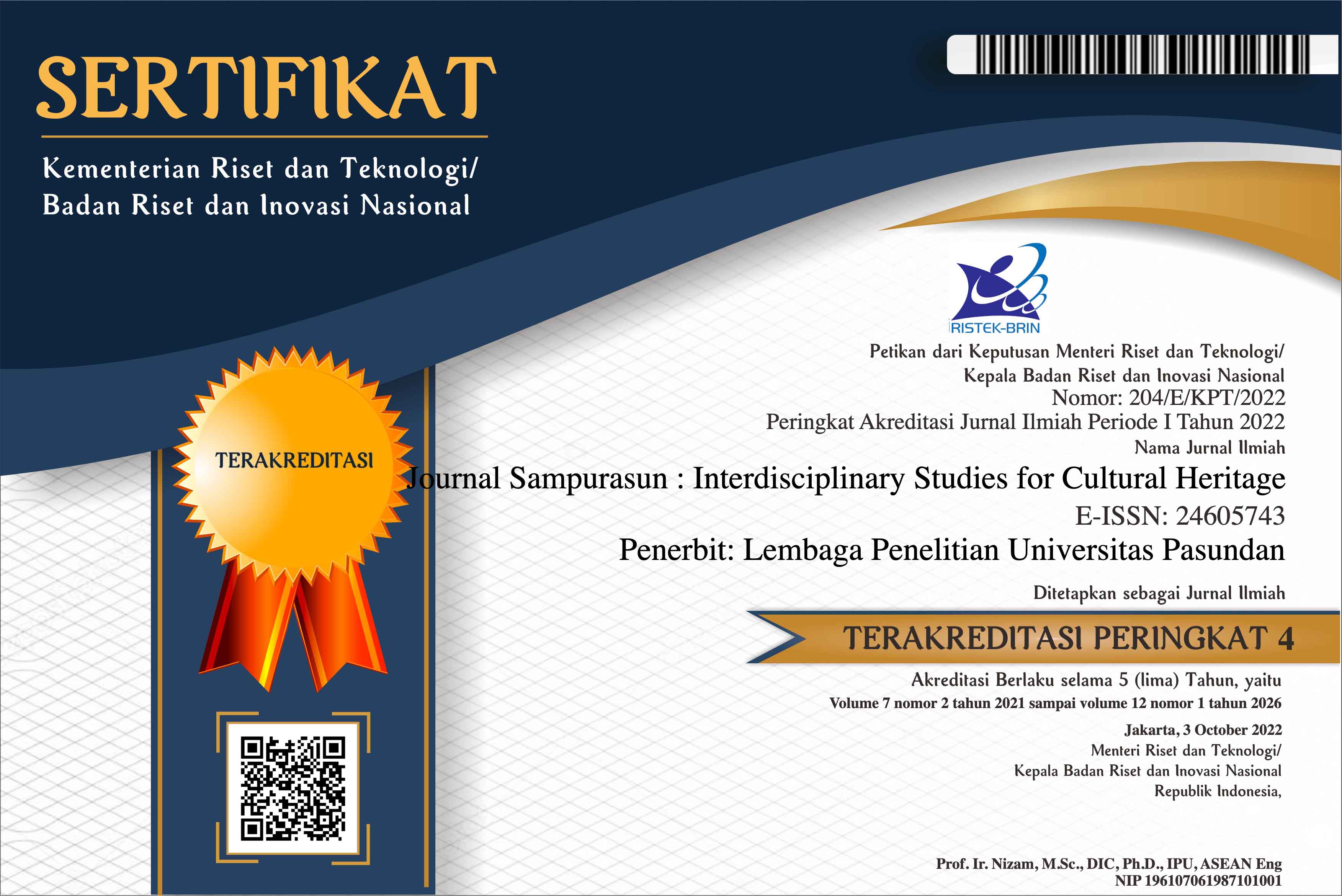HERITAGE MANAGEMENT PROBLEMS OF MEGALITHIC STONES IN GEDEO ZONE, SOUTHERN ETHIOPIA OBSERVATIONS FROM TUTU FELA AND CHELBA TUTUTI SITES
DOI:
https://doi.org/10.23969/sampurasun.v8i2.6266Keywords:
Megalithic Stones, Gedeo Zone, Tutu Fela, Chelba Tututi, heritage management problemsAbstract
Gedeo is the area where Africa’s largest megalithic stone concentration is found. This research aims to assess the heritage management problems of megalithic sites in Gedeo Zone, Ethiopia, with a focus on the Tutu Fella and Chelba Tututi sites. Methodologically, the study employed primary and secondary sources, which were collected through a literature review, field work, and interviews with local informants. The study shows that the megalithic stones have historical, archaeological, symbolical, artistic and commemorative significances which enable the sites to be major source of tourism development in the area. However, these multifaceted collective past memories are subjected to mismanagement activities that have a negative impact on the preservation of the megalithic stones. These problems are associated with the lack of awareness among the local community about the values and the need for the management of the megalithic stones, the expansion of Christianity and the subsequent socio-cultural changes in the area, the mismanagement of the site’s tourism activity, which is not supported by regular and legal means of collection of tourist entrance fees, the weakness of the local culture and tourism offices to employ protection activities for the sites, and the absence of continuous recording and promotion works on these features. The study also recommends the need for creating public platforms to increase the local community’s awareness of the importance of the sites, continuous recording and promotion, the use of legal frameworks to support heritage management and tourism development in the sites, and recognition of the sites as national heritage.
Downloads
References
Asebe Regasa (2007). Ethnicity and inter-ethnic relations: The ‘Ethiopian experiment’ and the case of the Guji and Gedeo. MA Thesis. Norway: Tromsø University.
Ashenafi Girma (2019). Megalithic stele monuments of Gedeo, South Ethiopia. Ph.D Dissertation. Washington: Washington State University.
Holl, F.C. (2021). Megaliths in Tropical Africa: Social dynamics and mortuary practices in ancient Senegambia (ca. 1350 BCE -1500 CE). International Journal of Modern Anthropology, 2(15), 363-412.
Joussaume, R. (2007). Megalithic cultures. In: Siegber Uhlig (Ed.), Encyclopedia Aethiopica, Volume 3, 911-912. Wiesbaden: Harrosswitze Verlag.
________. (2010a). Stelae. In: Siegber Uhlig (Ed.), Encyclopedia Aethiopica, Volume 4, 742-746. Wiesbaden: Harrosswitze Verlag.
_______. (2010b). Tuto Fela. In: S. Uhlig (Ed.), Encyclopedia Aethiopica , Vol. 4, pp. 1007-1008). Wiesbaden: Harrassowitz Verlag.
Krzemińska, A. E., Dzikowska, A., Zaręba, A. D. and Jarosz, K. R. (2018). The significance of megalithic monuments in the process of place identity creation and in tourism development. Open Geosci, 10, 504-516.
McClellan, C. W. (1988). State Transformation and National Integration: Gedeo And the Ethiopian Empire, 1895-1935. African Studies Centre, East Lansing, Michigan: Michigan State University
Sintayehu Demeke, Buruk Wolde-Michael and Tsegaye Zeleke (2020). Orthodox Christianity among the Gedeo, Southern Ethiopia: Inception and development to 1991. International Journal of Multicultural and Multireligious Understanding (IJMMU), 7(5), 668-678.
Tadesse Kippie (2002. Five Thousand Years of Sustainability?: A Case study on Gedeo Land Use (Southern Ethiopia). Heelsum: Treemail Publishers.
Tsegaye Ebabey (2019). Fachi'e and Deraro: Traditional epitomizes of confession and prosperity among the Gedeo people of Southern Ethiopia. International Journal of Current Research, 11(10), 7637-7645.
Wunderlich, M. (2019). Megalithic Monuments and Social Structures: Comparative studies on recent and Funnel Beaker societies. Leiden: Sidestone Press.
Downloads
Published
Issue
Section
License
Copyright (c) 2022 Journal Sampurasun : Interdisciplinary Studies for Cultural Heritage

This work is licensed under a Creative Commons Attribution 4.0 International License.
Copyright Notice
Authors should not withdraw their submitted papers because the withdrawal wastes voluntary works devoted by an associate editor and reviewers. But, we accept the withdrawal of a submitted paper if authors have unavoidable reasons. In the event that a manuscript is to be withdrawn from submission to Sampurasun Journal, a letter must be sent to the editorial office requesting withdrawal by e-mail (sampurasunjournal@unpas.ac.id) with its scanned PDF file, before the notification of acceptance for publication.
The withdraw request letter must include the following information. Paper ID, Paper title, Authors names, Reason why the paper must be withdrawn, and Date and signatures of all the authors (or signature of the contact author).
If only the contact author signs the letter, he/she must obtain the agreement of the withdrawal from all the other authors and the letter must include the description that all the other authors agreed the withdrawal. The journal will not withdraw a manuscript from peer review until such a letter has been received. Authors must not assume their manuscript has been withdrawn until they have received appropriate notification from the editorial office. Withdrawal of a manuscript subsequent to acceptance for publication will only be granted in the most exceptional of circumstances.
After the paper is accepted for publication, the withdrawal is not permitted in principle. The authors must always pay the charge even if the withdrawal is permitted. Any request of withdrawal that does not follow the above procedure is treated as invalid. If illegal submission, e.g., plagiarized or duplicate submission, is found for a paper, the withdrawal of the paper will never be permitted and the authors will be punished based on the rule. It is not acceptable practice to withdraw a manuscript in the event of acceptance at another journal. This constitutes dual submission. The editorial office of the other journal will be notified of your actions. In such circumstances Sampurasun ISCH may chose to impose appropriate punitive action subject.
Withdrawal Penalty
Author is not allowed to withdraw submitted manuscripts, because the withdrawal is waste of valuable resources that editors and referees spent a great deal of time processing submitted manuscript, money and works invested by the publisher. If author still requests withdrawal of his/her manuscript when the manuscript is still in the peer-reviewing process, author will be punished with paying $200 per manuscript, as withdrawal penalty to the publisher. However, it is unethical to withdraw a submitted manuscript from one journal if accepted by another journal. The withdrawal of manuscript after the manuscript is accepted for publication, author will be punished by paying US$500 per manuscript. Withdrawal of manuscript is only allowed after withdrawal penalty has been fully paid to the Publisher. If author don't agree to pay the penalty, the author and his/her affiliation will be blacklisted for publication in this journal. Even, his/her previously published articles will be removed from our online system.


















